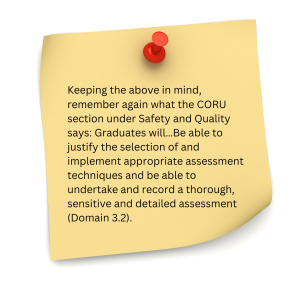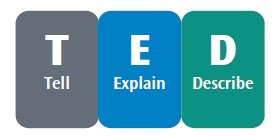Chapter 42 – Noel Howard (D3SOP2)
Domain 3 Standard of Proficiency 2
Be able to justify the selection of and implement appropriate assessment techniques and be able to undertake and record a thorough, sensitive and detailed assessment.
|
KEY TERMS Assess – to sit beside Assessment Strengths-based assessment
|
Social care is … in terms of meeting the identified needs of individuals, Social Care is a profession, built around and based on a relational approach, delivered by professionally qualified staff. |
We interpret what we see, and select the most workable of the multiple choices (Joan Didion 1979)
Assess – To Sit Beside
Interestingly, the English word ‘assess’ comes from the Latin assidere, meaning ‘to sit beside’. If one expands the idea of ‘sitting beside’ to mean ‘being with’, then social care workers are in a unique and, indeed, privileged position when it comes to assessment. Why? Social care workers spend a lot of time with those for whom they care, and accrue a depth of knowledge about those they work with, that few, if any, other professionals do. Some of that knowledge may be through using formal and informal techniques to ascertain certain wants, needs, problems, strengths and so on. However, beyond that, the closeness of living with someone every day gives many other insights. They are almost accidental, moments caught in time, and come about because of the relationship forged over time with the mutual ebb and flow of daily living and all its ups and downs.
Assessment
If you google ‘assessment’ you will get pages of different material from various quarters offering to give you a formula for assessing the needs of children and vulnerable adults. There are many different approaches that all claim to lead to better results for the individual being assessed. Much of the material is helpful, if somewhat repetitive, simply because there is only so much one can say about the subject. If you were to try to work your way through all the material that’s available you could go on for ever. Or you may be fortunate to work in a situation where your organisation has its own assessment process, which is regularly reviewed, and you may work happily and effectively with that. For example, the HSE has the Single Assessment Tool (SAT) for older people. In the UK there is guidance under the Care Act 2014, which gives good examples of how good assessments lead to improved quality of life for those in receipt of social services.

The first thing to remember is that whatever the age or situation of the individual being assessed, there are common elements, some obvious and perhaps some not so obvious, in all the assessment techniques available. In that context, and in order to choose the most appropriate assessment technique, it is important to be as certain as possible that what your assessment will yield will be understandable and clear for the person for whom it is intended. More important still – the key element – is that it will ultimately benefit the person being assessed. Individuals in receipt of social care services deserve the very best we can put into their care but also the best, objectively, that we write about them. And of course, to do that effectively, we must know and understand, to the highest degree possible, what their view is too. The 2012 children’s referendum has the voice of the child as a key component; this was very often not the case in the past. And we all know about Ireland’s past and its treatment of children, which leads to the next point.
In cases where you or your team’s assessment is for court purposes there may, in the case of children, be a number of other reports, including that of the guardian ad litem, a court-appointed individual whose sole aim is to represent the best interests of the child. You may very well say, ‘Are we not all to represent the best interests of the child?’ In other words, we are all there supposedly to ensure that what we say is what will ultimately be of benefit to the child. In theory that is the case. However, I am old enough to remember seeing different groups of officials, representing different departments (Health, Education and Justice), backed up by teams of lawyers, going in to court and all contending that they were there to represent the best interests of the same child. In fact, they were representing the best interests of their particular department and would fight tooth and nail to get their way even if it was obvious that they just wanted to hive off a problem (child) and move it as far away as possible from their responsibility. Often the result was to leave a child and a family in limbo, perhaps returning a child to a care setting that was totally inappropriate. Believe me, it happened. Always be aware that organisations – any organisation – often have their own interests to the fore. That’s a fact and will be reflected in their assessments of situations.
Doing Your Assessment
Your assessment, then, must be responsible, objective and thoroughly professional. It must be in the best interests of the individual being assessed, and not in anyone else’s best interests. In the context of the last paragraph, you may feel on occasion that your view or conclusion is being compromised. This can be by a staff team, influential staff member, manager or, indeed, the organisation you work for, which is ostensibly there to act in the best interests of those it is tasked with caring for and for which it is being paid. This is not to say that you should not reference or consider views other than your own within the staff team or the organisation. What is vital is that your assessment is reliable, valid and unbiased. An assessment report is a permanent record. Always admit to a genuine mistake – this can be a measure of your professionalism.
Strengths-based Assessments
The strengths, capacities, needs and preferences of the individual being assessed must be clear. This does not mean glossing over or minimising problems (which a court or other agency may be well aware of in any event). While particular assessment tools, such as a Problem Profile Approach, may seem to be focused on looking at the problems an individual has it can be helpful when used against an underlying principle of a strengths based approach. A strengths based approach can concentrate on what is evidence based and possible, especially into the future, assuming that particular problems can be effectively minimised in order for positive goals to be achieved in the medium to long term.
Assessment Tools
To be able to justify the selection and implementation of appropriate assessment techniques and be able to undertake and record a thorough, sensitive and detailed assessment, social care organisations need to create cultures that support workers with this task.
|
Key features of the organisational culture needed to support social care workers in undertaking detailed and sensitive assessments:
|
|
|
The importance of child observation. |
|
|
|
Central to any assessment is the child/young person’s voice and experience. Keeping the service user in view is central to sensitive assessment. This can, however, be difficult to achieve. This is one area that warrants attention, as often service users are not always seen or engaged with during the assessment process.
The Three Houses
As social care workers, we are all aware that it can be difficult for children and young people to share their experiences with us. It requires a lot of courage and trust to open up and allow us into their world. This can also be the same experience for parents, who are often afraid of professional interventions for fear of judgement and criticism. Parents can sometimes think that professionals are not interested in their experiences and views. When social care workers convey a non-judgemental attitude and demonstrate interest in service users’ views and experiences, they are more likely to engage with services in open and honest manner.
The Three Houses tool was developed by Nicki Weld and Maggie Greening. The resource Using the ‘Three Houses’ Tool: Involving Children and Young People in Child Protection Assessment and Planning was written by and is copyrighted by Nicki Weld and Sonja Parker.
The following section is an adapted extract from the booklet, which is free to download from http://www.partneringforsafety.com/uploads/2/2/3/9/22399958/three_houses_booklet_updated.pdf.
The House of Vulnerabilities or Worries
Vulnerabilities include past and present hurts and issues that can make a person more vulnerable to danger and harm such as addictions, anger, sadness, past and current experiences of violence, or being involved in or exposed to criminal activities. Worries might include these types of vulnerabilities and also anything that may make a child, young person or adult feel sad, angry, scared and ashamed, and therefore worried about.
Elicit the child’s views by using a broad question, such as one of the suggested questions below:
- Lots of kids I talk to often have worries. Worries might be things that make us feel sad, a bit scared, angry, or a maybe a bit bad.
- Are there any worries that you have at the moment?
- Can we put those in your house of worries?
- What are you feeling worried about at the moment?
- So what is happening that is worrying you at the moment?
The House of Strengths or Good Things
Exploring ‘Strengths’ or ‘Good things’ helps identify internal and external factors that are working well to support safety and wellbeing, and the things people feel good and okay about. The strengths and good things in a person’s world often become the resources and ways to help manage the vulnerabilities and worries, and also to support people to reach their hopes and dreams. Strengths and good things might include humour, supportive family members or friends, positive values and beliefs, faith, positive self-identity, good engagement in work or school, and skills or talents. If people do not have a few strengths in this house, this is likely to indicate a need and it may be necessary to include additional resources here to help.
Once the child is ready to start drawing or writing, or if you are writing for the child, it can be helpful to ask an initial eliciting question, such as:
- What are the good things that are happening in your life?
- What are the things in your life that make you feel happy?
- What is going well in your life at the moment?

The acronym TED is a helpful reminder to keep the questions in an open-ended format, so that there is no risk of you leading the child’s responses. TED stands for Tell, Explain, Describe and prompts you to ask open-ended follow-up questions, such as:
- Could you tell me more a little bit more about that?
- Could you explain what’s happening in this picture?
- Could you describe this picture a little more for me?
- Could you explain a little bit more about what you mean by that?
The House of Hopes and Dreams
This house explores what people would like to see happening in their world, especially in relation to their vulnerabilities or worries. This house helps us build understanding of what someone may like to be different in their world and their goals and aspirations around this. It is here that solutions and goals can start to be formed to build a future picture of increased safety and wellbeing. Without a future picture, people can become stuck and unable to see where they could be, or what might be, and thus feel less motivated to make positive changes. This is especially true for children, young people and adults who have experienced trauma and may have difficulty thinking longer-term or having goals and aspirations.
Questions to elicit child views:
- What are the important things that you want to have happening in your life that we need to put into your ‘house of hopes and dreams’?
- What would you like to have happening in your life?
- How would you like things to be in your life?
![]() Tips for Practice Educators
Tips for Practice Educators
- Really challenge students in terms of their values, attitudes, beliefs and prejudices.
- Stress that a report, to be effective, must read well as a narrative.
- Stress that grammar, syntax, etc. must be checked before any assessment report is submitted; poorly written reports reflect not only on the individual social care worker but on the profession as a whole.
- Students must have a clear understanding of what is fact, opinion, conjecture, hunch, intuition, etc.
- An assessment report is a permanent record.
- Mistakes can be made; admitting a genuine mistake can be a measure of one’s professionalism.
References
Department of Health (2014)The Care Act. London: Department of Health. https://www.scie.org.uk/ care-act-2014/transition-from-childhood-to-adulthood/young-carer-transition-in-practice/references. asp
HSE (2018) Assessment and Care of Older People using the Single Assessment Tool (SAT). Available from https://www.hse.ie/eng/services/list/4/olderpeople/sat.

